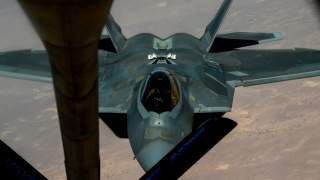What Good Are the F-35 and F-22 If They Can Be "Unstealthed"?
China is working on taking away the planes' greatest asset.
Key Point: Stealth is one of the most important attributes an aircraft can have.
China is trying to devise ways to make its nonstealthy aircraft radar resistant.
This week, the Hong Kong–based South China Morning Post reported that China is working on experimental technologies to make even its older aircraft appear stealthy to most radar systems. Citing scientists working on the project, the SCMP said, “The technology involves the use of a ‘metamaterial’, a fabricated layer comprising microscopic structures similar to integrated circuits. The metamaterial can alter the way radio waves bounce off its surface to create a ghost image or minimize echo on a radar, helping hide the aircraft in flight with greater efficiency.”
Apparently, the metamaterial was developed at the State Key Laboratory of Millimeter Waves in Southeast University, and is currently being tested in Shenyang, in Liaoning Province. The SCMP wasn’t able to get confirmation on which aircraft the metamaterial is being tested on, but noted that the local Shenyang Aircraft Corporation makes the J-11 and the J-15. Both of these fighter jets lack stealth capabilities.
The metamaterial is not the only kind of radar tricking technique that the team at State Key Laboratory is engaged in. The SCMP went on to report that the team earlier discussed a “ghost illusion device.” The ghost illusion device, according to the team working on it, “could make parts of the plane appear on radar as plastic, instead of metal, or show three planes instead of one.”
In theory, being able to convert nonstealthy aircraft into stealthy jets would be an incredible boon for Chinese air power. As the article notes, China currently only has about twenty J-20 stealth fighters, compared to 1,500 other kinds of combat aircraft. But as the SCMP itself has already reported, even the J-20 might not be stealthy as China has claimed. According to a February report, “China rushed its first advanced stealth fighter jet into service ahead of schedule last year, using stopgap engines, in the face of rising security challenges in the region.” Specifically, the W-15 engine that was supposed to power the J-20 exploded during trial flights. Beijing has been unable to fix this issue, and therefore its initial J-20s are using WS-10B engines. These are a modified version of the engines that China’s J-10 and J-11 fighters use. The WS-10B’s thrust-to-weight ratio is not able to power the J-20 to supersonic speeds without the use of afterburners, which makes the jet unstealthy at those speeds.
This all points to another issue with the metamaterial fix for China’s nonstealthy planes. Namely, that stealth comes from a number of different features on planes. As one of the earliest developers of stealth technology put it, the four most important features of stealth are “shape, shape, shape and materials.” And, as Wired magazine has noted, other stealth components include “chemicals to eliminate telltale contrails; sophisticated, untraceable sensors and radios; specially designed, hard-to-detect engine inlets; radar-canceling paint; and cooling systems for reducing a plane's heat signature.” Of those materials, metamaterial would seem to be mimicking, to some extent, the effect of Radar-Absorbing Material (RAM). But, it’s unclear if metamaterial could cover up some of the other nonstealth features. For instance, if the older planes are still using inferior engines, could metamaterial still conceal their heat signature? Han Yiping, the director of applied physics at Xidian University, doubts it, telling the SCMP that you would have to sacrifice performance to achieve sufficient reliability.
Han also noted other shortcomings of metamaterial. First, according to Han, presently metamaterial is only effective against certain radio bandwidths, although she doesn’t specify which ones. She also said that metamaterials are extremely hard to produce on a mass level, although the SCMP claimed that “recent Chinese reports suggested that they were starting to develop the mass use of metamaterials on the mainland.” Han’s far from the only Chinese scientist who is skeptical of the State Key Laboratory team’s claims. An unnamed researcher at the Chinese Academy of Sciences was also quoted as saying that, in the scientific community, “The consensus is that their product still has a lot of room for improvement.”
China is not the only country working on metamaterial. As the Financial Times has noted, “Metamaterials first captured the public imagination in 2006, when John Pendry of Imperial College published two papers showing how to create a Harry Potter-style invisibility cloak using the specially engineered materials.” Since then, many companies have been developing the technology for commercial purposes. These include making satellite antennas and sensors lighter and more portable. For instance, one company, Kymeta, produces antennas that enable transportation vehicles like cars, trains and yachts to connect to the internet. Other companies are exploring ways to improve solar panels and radars to integrate drones, according to the FT article.
Of course, other militaries are also working with the technology, including the U.S. Army, which wants to create “wearable camouflage with a chameleon-like ability to change according to the background.” This may use metamaterials, but it’s unclear how realistic any of this really is.
Zachary Keck (@ZacharyKeck) is a former managing editor of the National Interest. This piece was originally featured in April 2018 and is being republished due to reader's interest.
Media: Reuters

